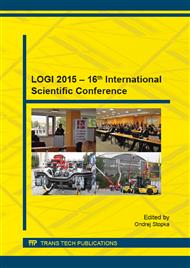[1]
J.E. Quintela Varajao, M.M. Cruz-Cunha, G.D. Putnik, A. Trigo, Enterprise Information Systems, Springer, Berlin, (2010).
Google Scholar
[2]
R. Andergassen, F. Nardini, M. Ricottilli, Innovation and Growth through Local and Global Interaction, In: Journal of Economic Dynamics & Control, Vol. 33 (2009) 1779-1795.
DOI: 10.1016/j.jedc.2009.04.003
Google Scholar
[3]
M.M. Cruz-Cunha, Social, Managerial and Organisational Dimension of Enterprise Information Systems, In: IGI Global, Business Sci. Ref., Hershey, (2009).
Google Scholar
[4]
I.T. Cameron, G.D. Ingram, A Survey of Industrial Process Modelling Across the Product and Process Life Cycle, In: Computers and Chemical Engineering, Vol. 32 (2008) 420-438.
DOI: 10.1016/j.compchemeng.2007.02.015
Google Scholar
[5]
O. Zizlavsky, Management Control of Innovative Activities: Research Results from Czech Manufacturing Industry, In: Proceedings of the 7th international scientific conference finance and performance of firms in science, education and practice, Tomas Bata University in Zlin, Czech Republic, pp.1708-1725, (2015).
DOI: 10.24818/imc/2021/04.02
Google Scholar
[6]
V. Chiesa, F. Frattini, Evaluation and Performance Measurement of Research and Development: Techniques and Perspectives for Multi-level Analysis, Cheltenham, Edward Elgar, (2009).
Google Scholar
[7]
O. Stopka, R. Kampf, J. Kolar, I. Kubasakova, Identification of Appropriate Methods for Allocation Tasks of Logistics Objects in a Certain Area, In: Our Sea, International Journal of Maritime Science & Technology, Vol. 61, No. 1-2 (2014) 1-6.
Google Scholar
[8]
W. Edwards, The Theory of Decision Making, in: Psychological Bulletin, Vol. 51, No. 4 (1954) 380-417.
Google Scholar
[9]
D.R. Anderson, D.J. Sweeney, T.A. Williams, J.D. Camm, R. Kipp Martin, An Introduction to Management Science: Quantitative Approaches to Decision Making, South-Western College Pub., 2010, 1045 p.
Google Scholar
[10]
R.T. Clemen, Making Hard Decisions: An Introduction to Decision Analysis, Boston: PWS Kent, (1991).
Google Scholar
[11]
R. Keeney, H. Raiffa, Decisions with Multiple Objectives, Preferences and Value Trade-offs, Cambridge University Press, Cambridge & New York, 1976, 569 p.
DOI: 10.1017/cbo9781139174084
Google Scholar
[12]
E.K. Zavadskas, Z. Turskis, Multiple Criteria Decision Making (MCDM) Methods in Economics: An Overview, In: Technological and Economic Development of Economy, Vol. 17, No. 2 (2011) 397-427.
DOI: 10.3846/20294913.2011.593291
Google Scholar
[13]
C. Zopounidis, P.M. Pardalos, Handbook of Multicriteria Analysis: Applied Optimization, Springer-Verlag Berlin/Heidelberg, Vol. 103 (2010).
Google Scholar
[14]
J. Jablonsky, Operations Research: Quantitative Models for Economic Decision Making, 3rd ed., Professional Publishing: Prague, 2007, 323 p.
Google Scholar
[15]
T.L. Saaty, Decision Making for Leaders: The Analytic Hierarchy Process for Decisions in a Complex World, RWS Publications, Pittsburgh, Pennsylvania, 1990, 292 p.
Google Scholar
[16]
T.L. Saaty, Theory and Applications of the Analytic Network Process, RWS Publications, Pittsburgh, Pennsylvania, 2005, 352 p.
Google Scholar
[17]
T.L. Saaty, Decision Making with the Analytic Hierarchy Process, In: International Journal of Services Sciences, Vol. 1, No. 1 (2008) 83-98.
Google Scholar
[18]
J. Siroky, V. Cempirek, J. Gasparik, Transport Technology and Control, Monograph, Tribun EU Brno, 2014, 238 p.
Google Scholar
[19]
J. Siroky, Disassembled Vehicle Combined Transport System, In: Applied Mechanics and Materials, Vol. 708 (2014) 153-158.
DOI: 10.4028/www.scientific.net/amm.708.153
Google Scholar
[20]
G. Fedorko, A. Rosova, V. Molnar, The application of computer simulation in solving traffic problems in the urban traffic management in Slovakia, In: Theor. Empir. Res. Urban Manag., Vol. 9 (2014) 5-17.
Google Scholar
[21]
G. Fedorko, M. Weiszer, Configuring the parameters of multi-objective evolutionary algorithm for integrated timetabling and vehicle scheduling in public transport, In: Congr. Proc. - CLC 2012 Carpathian Logist. Congr., 2012, pp.435-440.
Google Scholar
[22]
S. Krile, M. Krile, P. Prusa, Non-Linear Mimimax Problem For Multi-Stop Flight Routes, In: Transport, Vilnius, Litvania, Vol. 10 (2015).
DOI: 10.3846/16484142.2015.1091984
Google Scholar
[23]
M. Trpisovsky, P. Prusa, Regional Public Transportation Services Modelling, In: Our Sea: Journal of Marine Science, Vol. 61, No. 3-4 (2014) 77-82.
Google Scholar


